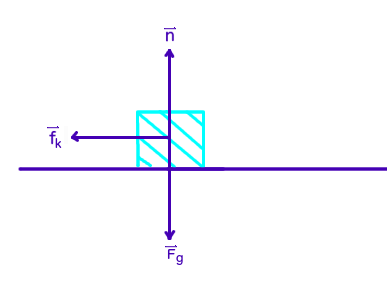If an object is moving at #15 m/s# over a surface with a kinetic friction coefficient of #u_k=25 /g#, how far will the object continue to move?
1 Answer
The object will travel
Explanation:
Given the kinetic friction coefficient of
My solution uses the work-energy theorem.
#W=DeltaE_(system)#
#=>W_(n e t)=DeltaK#
We can use that the net work done on the object is equal to the change in kinetic energy to calculate the distance traveled by the object. If friction were not involved, energy would be conserved, i.e. there would be no change in energy of the system (
A force diagram for this situation would look something like this:

Where
It is important to realize that only forces which act parallel to the motion of the object do work on the object. This means that the force of friction is the only force present in this situation which does work. The equation for work is given by
The force of kinetic friction works opposite the direction of motion to slow the object down, so
The object is moving initially, but we want to know how far it travels, or how far it moves before it stops. Therefore, the object is at rest finally, or has
#DeltaK=1/2m(v_f)^2-1/2m(v_i)^2#
We determined that the object should be at rest finally and therefore have no final velocity, giving:
#DeltaK=-1/2m(v_i)^2#
Back to our work-energy equation:
#W=DeltaK=-1/2m(v_i)^2#
And we determined that the only work done is by friction:
#=>W_F=-1/2m(v_i)^2#
From the above equation for work,
#W_f=-vecf_k*Deltar#
We know that the force of kinetic friction is given by:
#vecf_k=mu_kvecn#
From a vertical sum of forces statement for the object:
#sumvecF_y=vecn-vecF_g=cancel(mveca)=0#
#=>vecn=vecF_g#
#=>vecn=mg#
So we have now that:
Back to our work-energy equation:
#-mu_kmg*Deltar=-1/2m(v_i)^2#
Rearrange to solve for
#Deltar=(cancel-1/2cancelm(v_i)^2)/(cancel-mu_kcancelmg)#
Cancel negative signs and mass
#Deltar=(1/2(v_i)^2)/(mu_kg)#
Given that
#Deltar=(1/2(15m/s)^2)/(25/cancel9.8*cancel9.8m/s^2)#
#Deltar=(225/2m^2/s^2)/(25m/s^2)#
#Deltar=(225/2m^(cancel2)/cancels^2)*(cancels^2/(25cancelm))#
#Deltar=225/50m=4.5m#
Because the answer works out fairly well, I assume that is what is meant by
#Deltar=(225/2m^2/s^2)/(25/g*9.8m/s^2)#
#Deltar=(225/2m^2/s^2)/(245/gm/s^2#
#Deltar=(225/2m^(cancel2)/cancels^2)*(gcancels^2)/(245cancelm)#
#Deltar=(225g)/(490)m#
#Deltar=(45g)/98m#
Where

